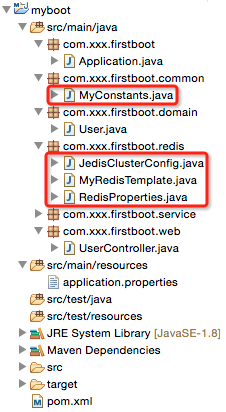第三章 springboot + jedisCluster(转载)
本编博客转发自:http://www.cnblogs.com/java-zhao/p/5347703.html
如果使用的是redis2.x,在项目中使用客户端分片(Shard)机制。
如果使用的是redis3.x中的集群,在项目中使用jedisCluster。
1、项目结构

2、pom.xml
<?xml version="1.0" encoding="UTF-8"?>
<project xmlns="http://maven.apache.org/POM/4.0.0" xmlns:xsi="http://www.w3.org/2001/XMLSchema-instance"
xsi:schemaLocation="http://maven.apache.org/POM/4.0.0 http://maven.apache.org/maven-v4_0_0.xsd"> <modelVersion>4.0.0</modelVersion> <groupId>com.xxx</groupId>
<artifactId>myboot</artifactId>
<version>1.0-SNAPSHOT</version> <properties>
<java.version>1.8</java.version><!-- 官方推荐 -->
</properties>
<!-- 引入spring-boot-starter-parent做parent是最好的方式,
但是有时我们可能要引入我们自己的parent,此时解决方式有两种:
1)我们自己的parent的pom.xml的parent设为spring-boot-starter-parent(没有做过验证,但是感觉可行)
2)使用springboot文档中的方式:见spring-boot-1.2.5-reference.pdf的第13页
-->
<parent>
<groupId>org.springframework.boot</groupId>
<artifactId>spring-boot-starter-parent</artifactId>
<version>1.2.5.RELEASE</version>
</parent> <!-- <dependencyManagement>
<dependencies>
<dependency>
Import dependency management from Spring Boot
<groupId>org.springframework.boot</groupId>
<artifactId>spring-boot-dependencies</artifactId>
<version>1.2.5.RELEASE</version>
<type>pom</type>
<scope>import</scope>
</dependency>
</dependencies>
</dependencyManagement> --> <!-- 引入实际依赖 -->
<dependencies>
<dependency>
<groupId>org.springframework.boot</groupId>
<artifactId>spring-boot-starter-web</artifactId>
</dependency>
<dependency>
<groupId>redis.clients</groupId>
<artifactId>jedis</artifactId>
</dependency>
<dependency>
<groupId>com.alibaba</groupId>
<artifactId>fastjson</artifactId>
<version>1.1.15</version>
</dependency>
<dependency>
<groupId>org.apache.commons</groupId>
<artifactId>commons-lang3</artifactId>
<version>3.3.2</version>
</dependency>
</dependencies> <build>
<plugins>
<!-- 用于将应用打成可直接运行的jar(该jar就是用于生产环境中的jar) 值得注意的是,如果没有引用spring-boot-starter-parent做parent,
且采用了上述的第二种方式,这里也要做出相应的改动 -->
<plugin>
<groupId>org.springframework.boot</groupId>
<artifactId>spring-boot-maven-plugin</artifactId>
</plugin>
</plugins>
</build>
</project>
说明:相对于上一章的代码仅仅引入了jedis的依赖jar。
3、application.properties
#user info
user.id=1
user.username=zhaojigang
user.password=123 #redis cluster
redis.cache.clusterNodes=localhost:8080
redis.cache.commandTimeout=5
#unit:second
redis.cache.expireSeconds=120
说明:相对于上一章的代码仅仅引入了redis cluster的配置信息
4、Application.java(springboot启动类,与上一章一样)
5、RedisProperties.java(Redis属性装配)
package com.xxx.firstboot.redis; import org.springframework.boot.context.properties.ConfigurationProperties;
import org.springframework.stereotype.Component; @Component
@ConfigurationProperties(prefix = "redis.cache")
public class RedisProperties { private int expireSeconds;
private String clusterNodes;
private int commandTimeout; public int getExpireSeconds() {
return expireSeconds;
} public void setExpireSeconds(int expireSeconds) {
this.expireSeconds = expireSeconds;
} public String getClusterNodes() {
return clusterNodes;
} public void setClusterNodes(String clusterNodes) {
this.clusterNodes = clusterNodes;
} public int getCommandTimeout() {
return commandTimeout;
} public void setCommandTimeout(int commandTimeout) {
this.commandTimeout = commandTimeout;
} }
说明:与上一章的User类似,采用@ConfigurationProperties注解自动读取application.properties文件的内容并装配到RedisProperties的每一个属性中去。
6、JedisClusterConfig.java(获取JedisCluster单例)
package com.xxx.firstboot.redis; import java.util.HashSet;
import java.util.Set; import org.springframework.beans.factory.annotation.Autowired;
import org.springframework.context.annotation.Bean;
import org.springframework.context.annotation.Configuration; import redis.clients.jedis.HostAndPort;
import redis.clients.jedis.JedisCluster; @Configuration
public class JedisClusterConfig { @Autowired
private RedisProperties redisProperties; /**
* 注意:
* 这里返回的JedisCluster是单例的,并且可以直接注入到其他类中去使用
* @return
*/
@Bean
public JedisCluster getJedisCluster() {
String[] serverArray = redisProperties.getClusterNodes().split(",");//获取服务器数组(这里要相信自己的输入,所以没有考虑空指针问题)
Set<HostAndPort> nodes = new HashSet<>(); for (String ipPort : serverArray) {
String[] ipPortPair = ipPort.split(":");
nodes.add(new HostAndPort(ipPortPair[0].trim(), Integer.valueOf(ipPortPair[1].trim())));
} return new JedisCluster(nodes, redisProperties.getCommandTimeout());
} }
说明:
- 该类注入了RedisProperties类,可以直接读取其属性
- 这里没有对jedis链接池提供更多的配置(jedis-2.5.x好像不支持,jedis-2.6.x支持),具体的配置属性可以查看文章开头第一篇博客
注意:
- 该类使用了Java注解,@Configuration与@Bean,
- 在方法上使用@Bean注解可以让方法的返回值为单例,
- 该方法的返回值可以直接注入到其他类中去使用
- @Bean注解是方法级别的
- 如果使用的是常用的spring注解@Component,
- 在方法上没有注解的话,方法的返回值就会是一个多例,
- 该方法的返回值不可以直接注入到其他类去使用
- 该方式的注解是类级别的
7、MyRedisTemplate.java(具体redis操作)
package com.xxx.firstboot.redis; import org.slf4j.Logger;
import org.slf4j.LoggerFactory;
import org.springframework.beans.factory.annotation.Autowired;
import org.springframework.stereotype.Component; import redis.clients.jedis.JedisCluster; @Component
public class MyRedisTemplate {
private static final Logger LOGGER = LoggerFactory.getLogger(MyRedisTemplate.class); @Autowired
private JedisCluster jedisCluster; @Autowired
private RedisProperties redisProperties; private static final String KEY_SPLIT = ":"; //用于隔开缓存前缀与缓存键值 /**
* 设置缓存
* @param prefix 缓存前缀(用于区分缓存,防止缓存键值重复)
* @param key 缓存key
* @param value 缓存value
*/
public void set(String prefix, String key, String value) {
jedisCluster.set(prefix + KEY_SPLIT + key, value);
LOGGER.debug("RedisUtil:set cache key={},value={}", prefix + KEY_SPLIT + key, value);
} /**
* 设置缓存,并且自己指定过期时间
* @param prefix
* @param key
* @param value
* @param expireTime 过期时间
*/
public void setWithExpireTime(String prefix, String key, String value, int expireTime) {
jedisCluster.setex(prefix + KEY_SPLIT + key, expireTime, value);
LOGGER.debug("RedisUtil:setWithExpireTime cache key={},value={},expireTime={}", prefix + KEY_SPLIT + key, value,
expireTime);
} /**
* 设置缓存,并且由配置文件指定过期时间
* @param prefix
* @param key
* @param value
*/
public void setWithExpireTime(String prefix, String key, String value) {
int EXPIRE_SECONDS = redisProperties.getExpireSeconds();
jedisCluster.setex(prefix + KEY_SPLIT + key, EXPIRE_SECONDS, value);
LOGGER.debug("RedisUtil:setWithExpireTime cache key={},value={},expireTime={}", prefix + KEY_SPLIT + key, value,
EXPIRE_SECONDS);
} /**
* 获取指定key的缓存
* @param prefix
* @param key
*/
public String get(String prefix, String key) {
String value = jedisCluster.get(prefix + KEY_SPLIT + key);
LOGGER.debug("RedisUtil:get cache key={},value={}", prefix + KEY_SPLIT + key, value);
return value;
} /**
* 删除指定key的缓存
* @param prefix
* @param key
*/
public void deleteWithPrefix(String prefix, String key) {
jedisCluster.del(prefix + KEY_SPLIT + key);
LOGGER.debug("RedisUtil:delete cache key={}", prefix + KEY_SPLIT + key);
} public void delete(String key) {
jedisCluster.del(key);
LOGGER.debug("RedisUtil:delete cache key={}", key);
} }
注意:
这里只是使用了jedisCluster做了一些字符串的操作,对于list/set/sorted set/hash的操作,可以参考开头的两篇博客。
8、MyConstants.java(缓存前缀常量定义类)
package com.xxx.firstboot.common; /**
* 定义一些常量
*/
public class MyConstants {
public static final String USER_FORWARD_CACHE_PREFIX = "myboot:user";// user缓存前缀
}
注意:
- 根据业务特点定义redis的缓存前缀,有助于防止缓存重复导致的缓存覆盖问题
- 缓存前缀使用":"做分隔符,这是推荐做法(这个做法可以在使用redis-desktop-manager的过程看出来)
9、UserController.java(测试)
package com.xxx.firstboot.web; import org.apache.commons.lang3.StringUtils;
import org.springframework.beans.factory.annotation.Autowired;
import org.springframework.web.bind.annotation.RequestMapping;
import org.springframework.web.bind.annotation.RequestParam;
import org.springframework.web.bind.annotation.RestController; import com.alibaba.fastjson.JSON;
import com.xxx.firstboot.common.MyConstants;
import com.xxx.firstboot.domain.User;
import com.xxx.firstboot.redis.MyRedisTemplate;
import com.xxx.firstboot.service.UserService; /**
* @RestController:spring mvc的注解,
* 相当于@Controller与@ResponseBody的合体,可以直接返回json
*/
@RestController
@RequestMapping("/user")
public class UserController { @Autowired
private UserService userService; @Autowired
private MyRedisTemplate myRedisTemplate; @RequestMapping("/getUser")
public User getUser() {
return userService.getUser();
} @RequestMapping("/testJedisCluster")
public User testJedisCluster(@RequestParam("username") String username){
String value = myRedisTemplate.get(MyConstants.USER_FORWARD_CACHE_PREFIX, username);
if(StringUtils.isBlank(value)){
myRedisTemplate.set(MyConstants.USER_FORWARD_CACHE_PREFIX, username, JSON.toJSONString(getUser()));
return null;
}
return JSON.parseObject(value, User.class);
} }
说明:相对于上一章,只是添加了测试缓存的方法testJedisCluster。
测试:
在Application.properties右击-->run as-->java application,在浏览器输入"localhost:8080/user/testJedisCluster?username=xxx"即可。
附:对于redis的测试,我们有时需要查看执行set后,缓存是否存入redis的db中了,有两种方式
- 执行set后,get数据,之后修改数据,在get数据,比较两次get的数据是否相同即可
- 有时,这些数据是无法修改的(假设该数据是我们从第三方接口得来的),这个时候可以使用redis-desktop-manager这个软件来查看缓存是否存入redis(该软件的使用比较简单,查看官网)
第三章 springboot + jedisCluster(转载)的更多相关文章
- 第三章 springboot + jedisCluster
如果使用的是redis2.x,在项目中使用客户端分片(Shard)机制.(具体使用方式:第九章 企业项目开发--分布式缓存Redis(1) 第十章 企业项目开发--分布式缓存Redis(2)) 如果 ...
- 第五章 springboot + mybatis(转载)
本编博客转发自:http://www.cnblogs.com/java-zhao/p/5350021.html springboot集成了springJDBC与JPA,但是没有集成mybatis,所以 ...
- 第七章 springboot + retrofit(转载)
本篇博客转发自:http://www.cnblogs.com/java-zhao/p/5350861.html retrofit:一套RESTful架构的Android(Java)客户端实现. 好处: ...
- 第六章 springboot + 事务(转载)
本篇博客转发自:http://www.cnblogs.com/java-zhao/p/5350106.html 在实际开发中,其实很少会用到事务,一般情况下事务用的比较多的是在金钱计算方面. myba ...
- 第四章 springboot + swagger(转载)
此篇博客转发自:http://www.cnblogs.com/java-zhao/p/5348113.html swagger用于定义API文档. 好处: 前后端分离开发 API文档非常明确 测试的时 ...
- 【转载】Java垃圾回收内存清理相关(虚拟机书第三章),GC日志的理解,CPU时间、墙钟时间的介绍
主要看<深入理解Java虚拟机> 第三张 P84 开始是垃圾收集相关. 1. 1960年诞生于MIT的Lisp是第一门采用垃圾回收的语言. 2. 程序计数器.虚拟机栈.本地方法栈3个区域随 ...
- 《驾驭Core Data》 第三章 数据建模
本文由海水的味道编译整理,请勿转载,请勿用于商业用途. 当前版本号:0.1.2 第三章数据建模 Core Data栈配置好之后,接下来的工作就是设计对象图,在Core Data框架中,对象图被表 ...
- [Effective Java]第三章 对所有对象都通用的方法
声明:原创作品,转载时请注明文章来自SAP师太技术博客( 博/客/园www.cnblogs.com):www.cnblogs.com/jiangzhengjun,并以超链接形式标明文章原始出处,否则将 ...
- (转)iOS Wow体验 - 第三章 - 用户体验的差异化策略
本文是<iOS Wow Factor:Apps and UX Design Techniques for iPhone and iPad>第三章译文精选,其余章节将陆续放出.上一篇:Wow ...
随机推荐
- centos下ssh无密码验证
#安装openssh-clients,rsync等#1.修改所有master和slave服务器的sshd_config,后面增加UseDNS noClientAliveInterval 30RSAAu ...
- What is Agile
Agile is a set of Values, Principles and Practices, that will change your behavior to will create gr ...
- ubuntu14.04下安装cudnn5.1.3,opencv3.0,编译caffe及配置matlab和python接口过程记录
已有条件: ubuntu14.04+cuda7.5+anaconda2(即python2.7)+matlabR2014a 上述已经装好了,开始搭建caffe环境. 1. 装cudnn5.1.3,参照: ...
- boost.numpy编译报错:undefined reference to `PyInt_FromLong' libboost_numpy.so: undefined reference to `PyCObject_AsVoidPtr'
[ 31%] Built target boost_numpy[ 36%] Building CXX object libs/numpy/example/CMakeFiles/dtype.dir/dt ...
- python学习心得第三章
python学习心得第三章 1.三元运算 变量=值1 if 条件 else 值2 由图如果条件成立则赋值1给变量,如果条件不成立则赋值2给变量. 2.数据类型 集合:set() class set(o ...
- sqlite3 转义字符
SqLite数据库的单引号转义是用单引号转义,并不是常用的"/" 参考:http://blog.csdn.net/qingflyer/article/details/6372498 ...
- Perl爬取铁路违章旅客信息
#! /usr/bin/perl use strict; use Encode qw(encode decode); binmode(STDIN,":encoding(utf8)" ...
- ngx.lua中遇到的小问题2
用lua+drizzle在数据库中插入数据失败(不能访问数据库) 后面发现原来是nginx配置文件中的drizzle模块部分最后多了一行 content_by_lua 'ngx.say(" ...
- reference
z@z:~$ g++ -std=c++11 ref.cpp ref.cpp:7:10: error: invalid conversion from 'int' to 'int*' [-fpermis ...
- 【python】迭代器&生成器
源Link:http://www.cnblogs.com/huxi/archive/2011/07/01/2095931.html 迭代器 迭代器是访问集合元素的一种方式.迭代器对象从集合的第一个元素 ...
